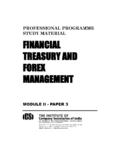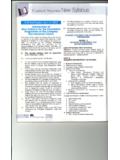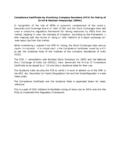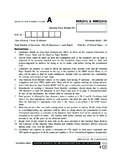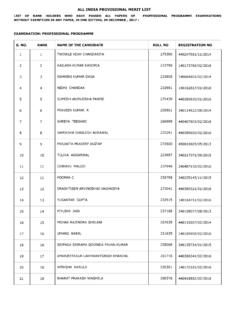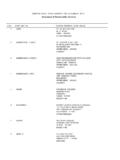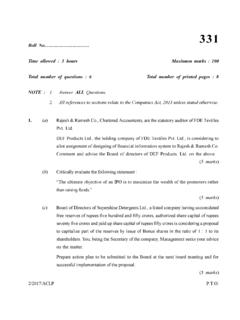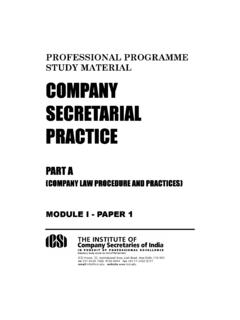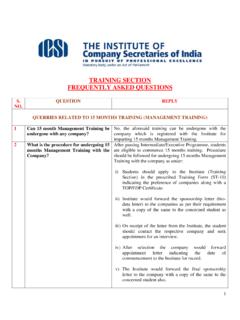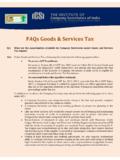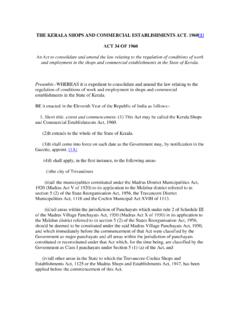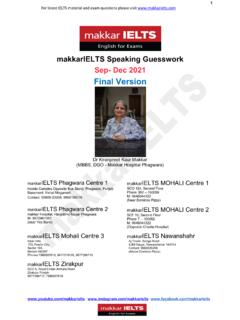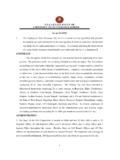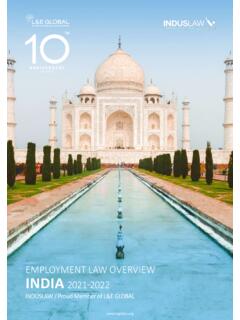Transcription of PRACTICE QUESTIONS Advanced Tax Laws (Relevant for June ...
1 1 PROFESSIONAL PROGRAMME MODULE 1, PAPER 2 PRACTICE QUESTIONS Advanced Tax Laws (Relevant for June 2021 examination) Part I Indirect Taxes [Goods and Services Tax (GST) and Customs Law] 2 March, 2021 THE INSTITUTE OF COMPANY SECRETARIES OF INDIA No part of this publication may be translated or copied in any form or by any means without the prior written permission of The Institute of Company Secretaries of India. DISCLAIMER: The PRACTICE QUESTIONS have been prepared by competent persons and the Institute hopes that it will facilitate the students in preparing for the Institute's examinations. It is, however, to be noted that the answers are to be treated as model answers and not as exhaustive and there can be alternative solutions available for the QUESTIONS .
2 The Institute is not in any way responsible for the correctness or otherwise of the answers. Students are expected to be well versed with the amendments in the Laws/ Rules made upto six months prior to the date of examination. 3 CONTENTS S. No. Chapter Page No. Goods and Services Tax GST (60 Marks) 1. An Overview on Goods and Services Tax (GST) 4 2. Supply 12 3. Input Tax Credit & Computation of GST Liability 26 4. Procedural Compliance under GST 39 5. Assessment, Audit, Scrutiny, Demand and Recovery, Advance Ruling, Appeals and Revision 53 6. Inspection, search, seizure, offences & penalties 59 7. GST practitioners, authorized representative, professional opportunities 73 8. Integrated Goods and Service Tax (IGST) 79 9. Union Territory Goods and Service tax (UTGST) 85 10. GST Compensation to States 88 11.
3 Industry/ Sector Specific Analysis 91 Customs Law (10 Marks) 94 4 Historical Background of Indirect Tax in India; International Perspective of GST/VAT; International Scenario of GST/VAT; Need for GST in India; GST Journey; Provisions under the Indian Constitution; Goods & Service Tax Council; Introduction of GST in India; Taxes Pre GST Regime, Concept of GST, Legislative framework of GST; Advantages of GST; Composition Scheme; Reverse Charge Mechanism; Exemption from GST Question 1 What is Goods and Services Tax (GST) and what exactly is the concept of destination based tax on consumption? Answer Goods and Services Tax (GST) is an Indirect Tax which has replaced many Indirect Taxes in India. The Goods and Service Tax Act was passed in the Parliament on March 29, 2017.
4 The Act came into effect on July 01, 2017. GST is a destination based tax on consumption of goods and services. It is levied at all stages right from manufacture to final consumption with credit of taxes paid at previous stages available as set-off. In a nutshell, only value addition will be taxed and burden of tax is to be borne by the final consumer. Destination based tax on consumption means the tax would accrue to the taxing authority which has jurisdiction over the place of consumption which is also termed as place of supply. Question 2 What are the basic features of Indirect Taxes? Answer The following are the basic features of Indirect Taxes: 1. Taxable Event: The indirect taxes are levied on purchase/sale/manufacture of goods and provision of services. 2. Incidence & Impact: In case of indirect taxes, the incidence and impact fall on two different persons.
5 It means the tax burden is shifted by the supplier to the buyer or recipient of goods or services. 3. Regressive Taxation: The indirect taxes do not depend on paying capacity as tax payable on commodity is same whether it is purchased by a poor man or rich person. Therefore, indirect taxes are regressive in nature. There are exceptions to this argument as higher taxes may be imposed on luxury goods. An Overview on Goods and Services Tax GST Chapter 1 5 4. Impact of Indirect Tax: The indirect tax on goods and services increases its price. This leads to inflationary trend. 5. Promotes Welfare: The harmful or sin products like alcohol, tobacco, etc. may be taxed at higher rate. This PRACTICE not only discourages consumption of such goods but also increases the revenue of the State.
6 6. Major Source of Revenue: In India, the contribution of indirect taxes to total tax revenue is more than 50%. Therefore, it is a major source of tax revenue for the Government. Question 3 What is cascading effect of Tax? Answer The cascading effect implies charging tax on tax. In other words, at the time of levy of tax, the total value is considered which is inclusive of all taxes paid up to that point. In this manner, if the tax is always charged on the selling price of the product, the burden of tax keeps on increasing at each point of sales. In this process, the effect of taxation magnifies as at each level tax is calculated on value, which includes taxes already levied and paid. The charging of tax on tax is called as Cascading Effect of tax.
7 Question 4 State the necessary pre-conditions for levy of Goods and Services Tax (GST) on goods and services. Answer The following conditions are required to be satisfied for a transaction to be chargeable to Goods and Services Tax, a) it involves supply of goods or services or both in terms of Section 7 of the CGST Act, 2017; b) the supply is a taxable supply; and c) the supply is made by a taxable person. Question 5 ACD Sweets Ltd., registered in kerala dealing in supply of sweets from its shop in city X". It has shops (units) in City Y and City Z in kerala and City W in Tamil Nadu. It transfers some of its stock from its shop in City X to its other units in kerala (intra-state) and Tamil Nadu(inter-state).Whether such self-supplies are taxable under Goods and Services Tax? Answer The definition of supply given under section 7 of CGST Act, 2017 is an inclusive one.
8 It does not specify that supply is to be made by one person to another. So, self-supplies are to be treated as supply in terms of section 7 of CGST Act. Establishment of same person in different states to be treated as establishment of distinct 6 person [Section 25(5) of CGST Act, 2017] Further, section 25(5) of CGST Act, 2017 provides that where a person who has obtained or is required to obtain registration in a State or Union territory in respect of an establishment, has an establishment in another State or Union territory or in the same state or Union territory provided such establishment is separately registered in GST, then such establishments shall be treated as establishments of distinct persons. Clause (2) of Schedule I of CGST Act, 2017 inter alia provides that supply of goods & services between distinct persons as specified in section 25 made in the course or furtherance of business is to be treated as supply even if made without consideration.
9 The legal position is thus crystalized that Inter-state self-supplies such as stock transfers, branch transfers or consignment sales shall be taxable under IGST even though such transactions may not involve payment of consideration and Intra-state self-supplies shall also be taxable provided the recipient is separately registered as business vertical. In view of the above discussed legal position, Inter State transfer of stock made by ACD Sweets Ltd. to its shop located in City W in Tamil Nadu are taxable under GST. Assuming that the shops of ACD Sweets Ltd. Located in City Y and City Z in kerala are not separately registered, self-supplies made to such shops are not taxable under GST. Question 6 What is GST Composition Scheme? What is the GST Composition Scheme Limit?
10 Answer GST Composition scheme is a tax paying mechanism offered to small businesses. When compared to normal GST filing, the composite scheme offers two main benefits: reduced paperwork and compliance, and lower tax liability. For instance, normal tax payers need to submit 3 monthly GST returns (GST-1, GST-2, and GST-3) and one annual return (GST 9). However, if a taxpayer has applied for the composition scheme GST, filing gets easier as they need to file just one quarterly return (GSTR 4), and one annual return (GSTR 9A). The composition scheme limit under GST varies depending on the type of business: For manufacturers and traders: As a newly registered business, the turnover should not exceed crores in the current financial year. If a taxpayer has already registered, then the turnover must not exceed crores in the previous financial year.
